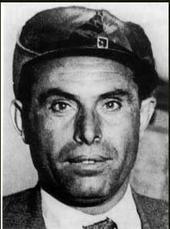I was a central figure of Spanish anarchism during the period leading up to and during the Spanish Civil War.
I was born in in León and started work at the age of 14 in the railway yard in León. In 1917 the socialist Unión General de Trabajadores (UGT) called a strike in which I was an active and prominent participant. The government brought in the Spanish Army to suppress the strike: they killed 70 people and injured more than 500 workers. 2,000 of the strikers were imprisoned without trial or legal process. I escaped to France.
During my exile until 1920, I worked in Paris as a mechanic. I was persuaded to go to Barcelona to organise the workers there. In Catalonia, with Juan GarcÃa Oliver, Francisco Ascaso, and a number of other anarchists, I founded Los Solidarios ("Solidarity"). Members of this group attempted unsuccessfully to blow up King Alfonso XIII. In 1923 the group was also implicated in the assassination of Cardinal Juan Soldevilla y Romero, as reprisals for the killing of Salvador SeguÃ. Ascaso, Oliver and I fled to Argentina.
I returned to Spain and Barcelona, becoming an influential militant within two of the largest anarchist organizations in Spain at the time, the Federación Anarquista Ibérica (FAI), and of the anarcho-syndicalist trade union Confederación Nacional del Trabajo (CNT). The influence my group gained inside the CNT caused a split, with a moderate faction under Ãngel Pestaña leaving in 1931 (becoming the Syndicalist Party).
Working closely with my comrade, I helped coordinate resistance to the military rising of Francisco Franco, successfully defeating General Goded's attempt to seize Barcelona. During the battle for the Atarazanas Barracks, my close friend and fellow militant Ascaso was shot dead. Less than a week later, on July 24, 1936 I led over 3000 armed anarchists (later to become known as the Durruti Column) from Barcelona to Zaragoza. After a brief and bloody battle at Caspe (in Aragon), we halted at Pina de Ebro, on the advice of a regular army officer, postponing an assault on Zaragoza.
In November 1936, I led 4000 militiamen to Madrid to aid the besieged Republican defenders of that city. On November 19, I was killed while leading a counter attack in the Casa de Campo area. According to author Anthony Beevor ('The Spanish Civil War', 1982), I was killed when a companion's machine pistol went off by mistake. At the time, the anarchists claimed I had been hit by an enemy sniper's bullet "for reasons of morale and propaganda." I died in a makeshift operating theatre set up in what was formerly the Ritz Hotel at the age of 40. My body was transported across country to Barcelona for my funeral. Over a quarter of a million people filled the streets to accompany the cortege during its route to the cemetery on Montjuich. It was the last large-scale public demonstration of anarchist strength of numbers during the bitter and bloody Civil War.
